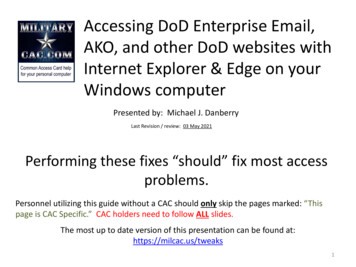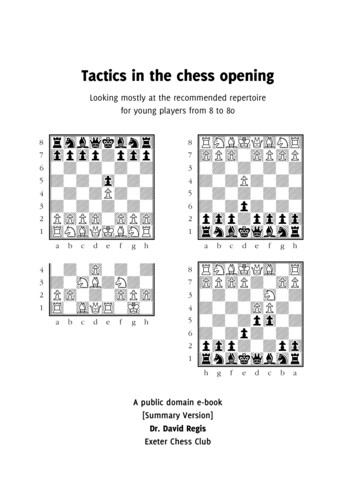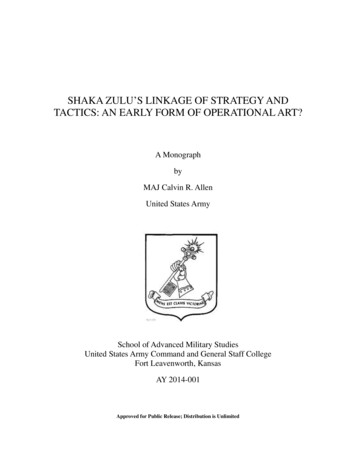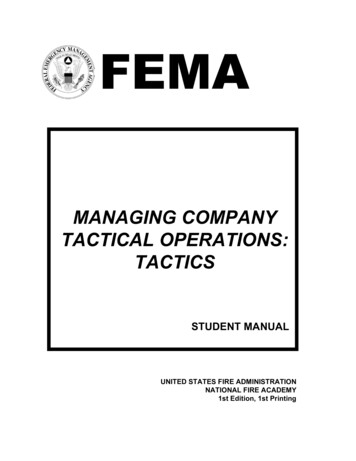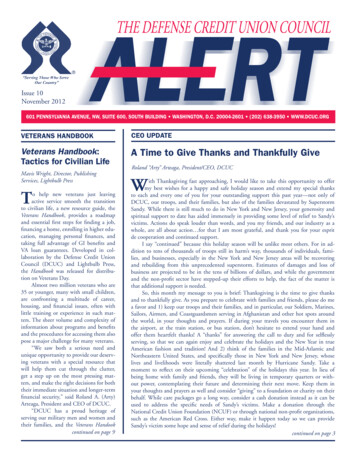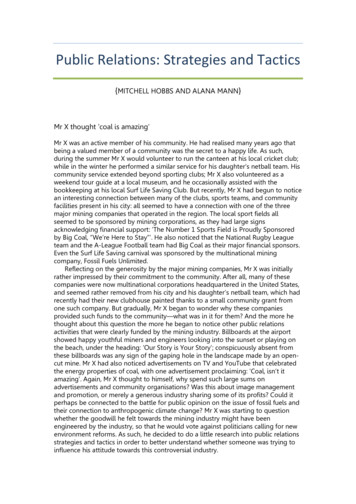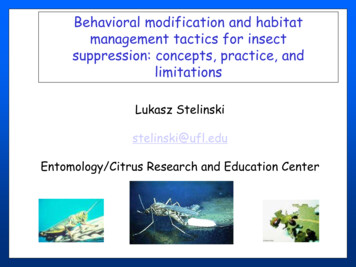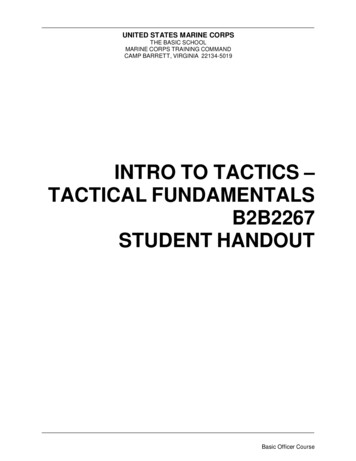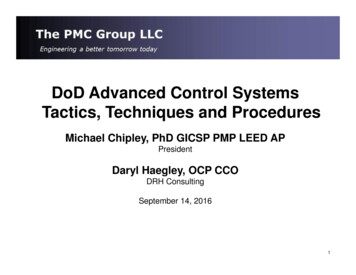
Transcription
DoD Advanced Control SystemsTactics, Techniques and ProceduresMichael Chipley, PhD GICSP PMP LEED APPresidentDaryl Haegley, OCP CCODRH ConsultingSeptember 14, 20161
In the Beginning .2010 Smart InstallationsA great idea rudely interrupted by reality CIO AMI ATO denial, and Stuxnetattack on Iranian Centrifuges2
Shodan Site Locates CSLegislation NDAA 2010 – Required an open protocol Unified Facility Guide Specification for Utility Monitoring ControlSystems (UFGS 25 10 10 published Nov 2012)Federal Standards NIST 800-53 Rev 4 Security and Privacy Controls for Federal Information Systems and Organizations – RiskManagement Framework (expected release Feb 2013) NIST 800-82 Rev 2 Guide to Industrial Control Systems (ICS) Security (expected publication Oct 2013) OMB 21st Century Digital Strategy – requires movement to Cloud and Web ServicesCommittee for National Security Systems CNSSI 1253 Security Categorization and Control Selection For National Security Systems Mar 2012 – requiresDoD to use NIST 800-53 and the development of ICS-PIT OverlaysDoD Policy DoDI 8500.01 Cybersecurity – replaces DIACAP with NIST Risk Management Framework (expected release Feb2013) CIO IT Modernization Strategy and Roadmap – requires data center and server consolidation CIO Mobile Device Strategy – instructs implementation of mobile devices on DoD networks CIO Cloud Computing Strategy – requires DoD to move to Cloud and Web Based ServicesServices Unified Facility Criteria – multiple UFC’s will need to be updated Engineering Technical Letters – multiple ETLS will need to be updatedUFCs and ETLs provide thedetailed “How To” guidance for theA&E’s, contractors, vendors andbuildersDoD has many CS systems directly connected to internet with no protection, http3
OT IP Controllers are in Everything4
Broader Cybersecurity Efforts‘12EEIM / AMITWG;MILDEP s Handbook‘13‘14‘15DoDI 8500Cybersecurity‘16DoDI 8530NetworkDoDI 8140WorkforceDoDI 8531VulnerabilityDoDI 8510Risk MgtFrameworkI&E ICSMemo 1I&E ICSMemo 2JMAAsHASCbrief 1CYBERCOMJBASICS TTPsHASCbrief 2Cybersecuring Facility Control Systems UFCSPIDERS Phases 1, 2, 3CSET 4.0, 5.1, 6.0, 6.2, 7.0, 7.1, 8.0CYBERGUARD14-1 Exercise NISTCyber-Physical SystemsRMF KS EI&E Control System webpageNIST SP 800-82 R2 ICSFFC Workshops5
“8 Star Memo”- Establish ClearOwnership- Include in Scorecard- Invest in DetectionTools- 7x cyber incidents6
NDAA 2017DoD facilities transitioning to smart buildings; increased connectivity has increased threat andvulnerability to cyber-attacks, particularly in ways existing DoD regulations were not designed toconsider. Therefore, SECDEF deliver a report:(1) Structural risks inherent in control systems and networks, and potential consequencesassociated with compromise through a cyber event;(2) Assesses the current vulnerabilities to cyber attack initiated through Control Systems (CS) atDoD installations worldwide, determining risk mitigation actions for current and futureimplementation;(3) Propose a common, DoD-wide implementation plan to upgrade & improve security of CS andnetworks to mitigate identified risks;(4) Assesses DoD construction directives, regulations, and instructions; require theconsideration of cybersecurity vulnerabilities and cyber risk in preconstruction designprocesses and requirements development processes for military construction projects; and(5) Assess capabilities of Army Corps of Engineers, Naval Facilities Engineering Command, AirForce Civil Engineer Center, and other construction agents, as well as participatingstakeholders, to identify and mitigate full-spectrum cyber-enabled risk to new facilities andmajor renovations.CS include, but are not limited to, Supervisory Control and Data Acquisition Systems, BuildingAutomation Systems Utility Monitoring and Energy Management and Control Systems. Suchreport shall include an estimated budget for the implementation plan, and delivered no later than180 days after the date of the enactment of this Act.7
DoDI 85302. APPLICABILITY. This instruction:b. Applies to the DoDIN. The DoDIN includes DoDinformation technology (IT) (e.g., DoD-owned orDoD-controlled information systems (ISs), platforminformation technology (PIT) systems, IT productsand services) as defined in DoDI 8500.01(Reference (h)) and control systems andindustrial control systems (ICS) as defined inNational Institute (NIST) Special Publication (SP)800-82 (Reference (i)) that are owned or operatedby or on behalf of DoD Components.8
Continuous Monitoring and Attack SurfacesHost BasedSecurity SystemsScanning (Active)Windows, LinuxHTTP, TCP, UDPMcAfeeNessusRetinaForcepointClient Side AttacksServer Side AttacksNetwork AttacksIntrusion DetectionSystems (Passive)PLC, RTU, SensorModbus, LonTalk,BACnet, DNP3Nessus Passive Vulnerability ScannerSophiaGrassMarlinOthers?Hardware Attacks9
What’s Next? DoD CIO Control Systems Scorecard Fall 2016Platform Resilience Mission Assurance effort starts Spring 2016JHUI-APL Cyber Threats, Gaps, Workforce Reports Fall 2016Cyber Ranges Control Systems Competition 2017Acquisition and contract language to require contractors and vendorsIT Business Systems to meet DoD standards (NIST SP 800-161) perDFAR 2015 – Compliance Date: Dec 2017DoDReal PropertyPortfolio 48 countries523 installations4,855 Sites562,600 buildingsand structures24.7 M acres 847 B value10
TTP Website Access WBDG and RMF KS1.Navigate to DoD CIO Knowledge Service(requires .org/resources/cybersecurity.php11
TTP ‘s Apply to IT and OTThe Tactics, Techniques and Procedures can be used by any organization andapply to:Information Technology (IT) Systems – Business and HomeOperational Technologies (OT) Systems – Any Kind (Utility, Building,Environmental, Medical, Logistics, Transportation, Weapons, etc.)At the conclusion of the workshop, you will appreciate your IT and OTnetworks in a new way and have situational awareness of normal versusabnormal behavior, know what actions to take, what contract language toadd to SOW’s, and how to protect sensitive information as the Internet ofThings and the convergence of IT and OT continues to evolve.For the foreseeable future, the trend to co-mingle IT and OT building controlsystems data on non-segmented networks is likely to be the norm; DON’TBE A TREND FOLLOWER, DON’T DO IT! Segment and VLAN IT and OT networks Separate the OS and OT data ( C: OS and D: OT data), enable BitLockeron OT drive12
New Draft Navy IA Guidance with the TTP’sTTP Jump-Kit Rescue CD13
ACT TTP for DoD ICSThe scope of the ACI TTP includes all DoD ICS. DoD ICS, which includesupervisory control and data acquisition (SCADA) systems, distributedcontrol systems (DCS), and other control system configurations, such as skidmounted programmable logic controllers (PLC) are typical configurations foundthroughout the DoD. ICS are often used in the DoD to manage sectors of criticalinfrastructure such as electricity, water, wastewater, oil and natural gas, andtransportation.3. How to Use These TTPThis ACI TTP is divided into essentially foursections: ACI TTP Concepts (chapters 2 through 4) Threat-Response Procedures(Detection, Mitigation, Recovery)(enclosures A, B, and C) Routine Monitoring of the Network andBaselining the Network (enclosures Dand E) Reference Materials (enclosures Fthrough I and appendix A through D)14
ACT TTP ConceptsACI TTP Concepts. The concepts provide background information to assist inexplaining the scope, prerequisites, applicability, and limitations of thecomponents of this TTP. The concept chapters should be read prior toresponding to indication of malicious cyber activity.In the 1990s, in order to leverage newly identified efficiencies in ICS,formerly physically isolated ICS networks were adapted to interface withthe Internet. In the early 2000s, active cyber threats were still in their infancy.However, today the cyber threat to ICS has grown from an obscure annoyanceto one of the most significant threats to national security (Rogers, 2015).The threat, coupled with the inherent lack of cyber security and a long-lifespan for ICS equipment, has created ideal conditions for a cyber attackcausing physical and tangible repercussions. This has led to a need fortactics, techniques, and procedures (TTP) relative to the operations oftraditional ICS equipment as well as information technology (IT) components.15
Threat-Response Proceduresb. Threat-Response Procedures (Detection, Mitigation, and Recovery).Detection Procedures (enclosure A) are designed to enable ICS and ITpersonnel to identify malicious network activity using officialnotifications or anomalous symptoms (not attributed to hardware orsoftware malfunctions). While the TTP prescribes certain functional areas interms of ICS or IT, in general each section is designed for execution by theindividuals responsible for the operations of the equipment, regardless offormal designations. Successful Detection of cyber anomalies is bestachieved when IT and ICS managers remain in close coordination. TheIntegrity Checks Table (enclosure A, section A.3, table A.3.1) lists theprocedures to use when identifying malicious cyber activity.16
Baselining and Routine MonitoringBaselining and Routine Monitoring of the Network.Before the ACI TTP are adopted, ICS and IT managers should establishwhat a FMC network is as it pertains to their specific installations andmissions. The ACI TTP defines FMC as a functional recovery point forboth the ICS and the SCADA. Once this is defined, ICS and IT managersshould capture the FMC condition of their network entry points (e.g., firewalls,routers, remote access terminals, wireless access points, etc.), networktopology, network data flow, and machine/device configurations, then storethese in a secure location. This information should be kept underconfiguration management and updated every time changes are made tothe network. This information forms the FMC baseline. The FMC baseline isused to determine normal operational conditions versus anomalousconditions of the ICS.Fully-Mission Capable (FMC Baseline) and Jump-Kit Rescue CD arecritical to implement Defend, Mitigate and Recover portions of the TTP17
Reference MaterialsReference Materials.To further enhance the ACI TTP as a tool, operators are encouraged to referto additional resources provided by the Industrial Control Systems CyberEmergency Response Team (ICS-CERT) and the National Institute ofStandards and Technology (NIST) Special Publication (SP) 800 ComputerSecurity series (see Appendix D: References).18
Detection, Mitigation, Recovery OverviewNavigating Detection, Mitigation, and Recovery ProceduresDetection, Mitigation, and Recovery Procedures are contained withinenclosures A through C. While Detection Procedures lead to MitigationProcedures, and Mitigation Procedures lead to Recovery Procedures,each enclosure can also be executed as a stand-alone resource as well asbe incorporated into local procedures. The following is an overview fornavigating the Detection, Mitigation, and Recovery portions of the TTP.19
Detection, Mitigation, Recovery Overview20
Detectiona. Detection.When a notification is received or an anomalous symptom is observed,the operator should locate the symptom on the Event Diagnostics Table(enclosure A.1 , table A.1.1 ). After locating and investigating the eventdiagnostics (which includes eliminating any non-cyber causes for the anomaly),the operator is directed to the Integrity Checks Table (enclosure A, section A.3,table A.3.1). These checks provide actions which assists the operator indetermining whether a cyber event is in progress or not. The operatorreturns to the diagnostic procedure and then decides either to continue withanother integrity check or exit the procedure by moving to the Mitigation sectionor returning to the Routine Monitoring section (enclosure D). In the case ofmalicious cyber activity, specific reporting procedures are provided. Theoperator is then directed to notify the ISSM and request permission to move tothe Mitigation section.21
Mitigationb. Mitigation.If the ISSM confirms permission to move to the Mitigation section, the operator’sfirst priority is to isolate any compromised assets, and protect thecommander’s mission priority through segmentation. This segmentation isbased on a predetermined segmentation strategy. After this step is complete, theoperator next ensures that local control has been achieved. After the system isstabilized, the operator can make a request to the ISSM to proceed to theRecovery section.For commercial office and non-government BCS, the owner or propertymanager determines the priorities; in most cases tenant service levelagreements have pre-defined requirements.It may not be possible to isolate all segments and the decision to continueusing the compromised BCS in a degraded mode may be the best option.If the IT and OT data is on the same segment (not on separate VLAN)’s, itshould be assumed that ALL BCS and owner and tenant IT systems arepotentially exploited.22
Recoveryc. Recovery.Recovery actions follow Mitigation actions. While the TTP addresses specificRecovery actions, operators may need to execute investigations, incidentresponse plans, and various other overarching command guidelines priorto executing any Recovery actions. Operators should ensure familiarity withthese policies and guidelines.23
Maintaining Operational ResilienceMaintaining Operational ResilienceAs cyber attacks have become focused and relevant in the world of cyberwarfare, the DoD has moved from a position of “system hardening” to aposture of maintaining operational resilience. With the release of Departmentof Defense Instruction (DoDI) 8500.01, Cybersecurity, in March of 2014, theDoD addresses the fact that cyber attacks are inevitable, and adversaries willsucceed to some degree. Therefore, it is incumbent upon all operational areasof the DoD to be prepared to meet these three conditions: ensure systems aretrustworthy, ensure the mission of the organization is prepared to operate withdegraded capabilities, and ensure systems have the means to prevail in theface of adverse events.The ACI TTP provides ICS operators with a means to use both bestpractices and procedures in the defense of the ICS, to degrade the ICS,if necessary, and to maintain system operations during an active cyberattack.24
Operational Security LogOperational Security LogThere are instructions throughout the ACI TTP threat-response proceduressections (enclosures A through C) to record information in a Security Log. Anoperational Security Log is a written organizational record of eventssuch that a reconstruction of events could occur to illustrate, over time,the adversarial cyber events that occurred on an ICS/IT network as wellas the organizational actions to Detect and/or counteract them. A logshould be designed to reflect and accommodate your environment andorganizational requirements.25
Chapter 2 – Detection ConceptsDetection Introductiona. Definition. The identification of evidence of an adversarial presence, or thedetermination of no adversarial presenceb. Key Components(1) Routine Monitoring(2) Inspection(3) Identification of adversarial presence(4) Documentation(5) Notificationsc. Prerequisites(1) FMC baseline(2) Routine Monitoring(3) Security LogDetection Process ACI TTP Entry Points1. Anomalies found during Routine Monitoring2. Organization directives, ICS-CERT Notices or other official notifications26
Detection Entry Points27
Chapter 3 – Mitigation ConceptsMitigation Introductiona. Definition. The actions taken that allow the CS network to continueoperating after the operator has separated the affected device and/or networksegment to prevent the propagation of the adversarial presence and toestablish control to allow end-state processes to continue to operate at thecommand-directed level without interference.b. Key Components(1) Protect the information network(2) Acquire and protect data for analysis(3) Maintain operations during an active attackc. Prerequisites(1) Identification of evidence of an adversarial presence(2) Appropriate notifications and reporting have been initiated(3) Security Log28
Chapter 3 – Mitigation Concepts (cont)Cyber Incident Analysis - It is important to note that Mitigation actions canvery easily destroy information or forensic evidence that could be useful infollow-on technical analysis of an incident. As such, it may become necessaryto conduct Mitigation Procedures without performing technical analysis to keep thesystem operational.Cyber Incident Response - Organizations must be prepared in advance for anyMitigation. Decisions made in haste while responding to a critical incident couldlead to further unintended consequences. Therefore, Mitigation Procedures,tools, defined interfaces, and communications channels and mechanismsshould be in place and previously tested.Mitigation Course of Action (COA) -Develop a plan that lists the specificMitigation steps to take and which identifies the personnel by jobdescription that should take those steps. In this way, when an incident doesoccur, appropriate personnel will know how to respond. Escalation procedures andcriteria must also be in place to ensure effective management engagement duringMitigation actions. Organizations must define acceptable risks for incidentcontainment and develop strategies and procedures accordingly. This shouldbe conducted during annual risk management activities.29
Chapter 4 – Recovery ConceptsRecovery Introductiona. Description. Restoration and reintegration of the CS to a FOC state.b. Key Components(1) Identify mission priorities(2) Acquire and protect data for analysis(3) Systematically Recover each affected device(4) Systematically reintegrate devices, processes, and network segments(5) Test and verify system to ensure devices are not re-infectedc. Prerequisites(1) Network has been isolated and stabilized from the cyber-incident(2) Appropriate notifications and reporting has occurred(3) Response Jump-Kit(4) Baseline documentation30
Chapter 4 – Recovery Concepts (cont)The operator must not proceed with Recovery Procedures without properauthorization and should consult with the ISSM prior to proceeding with thoseRecovery Procedures. A CPT from outside your organization may be calledupon to direct the Recovery process. The main focus of the CPT is topreserve forensic evidence for analysis of the cyber incident and toprovide technical assistance as required. If directed, the operator mayproceed with Recovery Procedures without the assistance of a CPT. Everyeffort should be made to preserve evidence of the cyber incident for forensicanalysis whenever feasible.Forensic evidence collection for BCS at this time is very difficult andtime consuming; very few building controllers have logs, are notauthenticated, and are on unencrypted networks.31
Chapter 4 – Recovery Concepts (cont)Recovery Processa. The Recovery phase begins once the system under attack has beenstabilized and infected equipment has been isolated from the network.Recovery of the systems will require the use of the resources located in theJump-Kit, the IT and CS system schematics, and the wiring and logic diagrams,and may require vendor assistance. Successful Recovery of the CS system afterthe cyber incident will depend upon the technical knowledge and skills of the CSand IT operators and will require a high level of communication and consultationbetween these team members and with the ISSM.b. Because of the wide variance in ICS/SCADA system design andapplications, these Recovery Procedures are not specific to a particularmake or model of equipment but are general in terms of application.32
Chapter 4 – Recovery Concepts (cont)c. The preferred method of Recovery is the removal and replacem
Retina Forcepoint Nessus Passive Vulnerability Scanner Sophia GrassMarlin Others? 10 DoD CIO Control Systems Scorecard Fall 2016 Platform Resilience Mission Assurance effort starts Spring 2016
